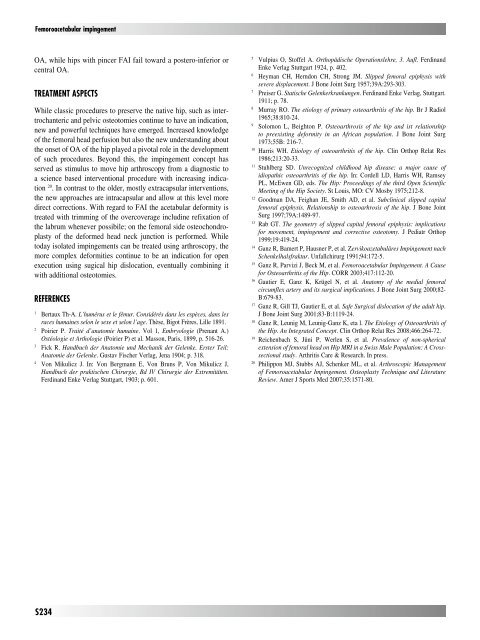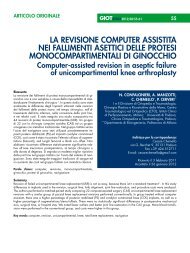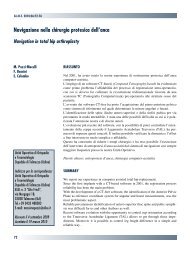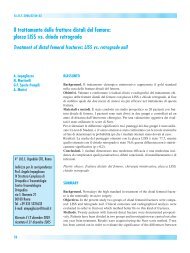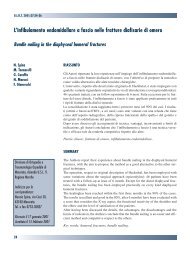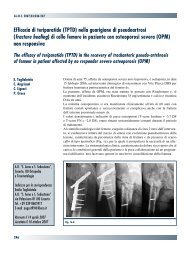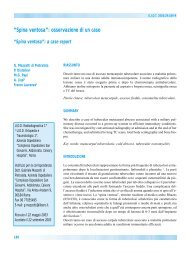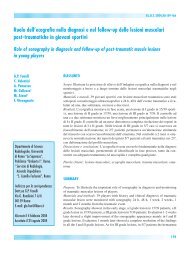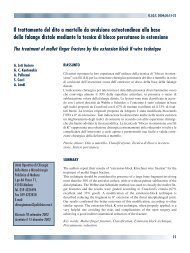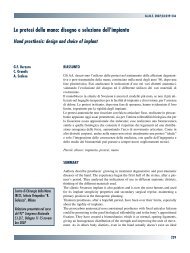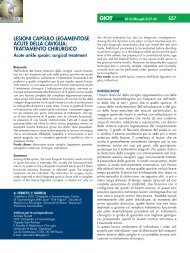30845 Suppl Giot.pdf - Giornale Italiano di Ortopedia e Traumatologia
30845 Suppl Giot.pdf - Giornale Italiano di Ortopedia e Traumatologia
30845 Suppl Giot.pdf - Giornale Italiano di Ortopedia e Traumatologia
You also want an ePaper? Increase the reach of your titles
YUMPU automatically turns print PDFs into web optimized ePapers that Google loves.
Femoroacetabular impingement<br />
OA, while hips with pincer FAI fail toward a postero-inferior or<br />
central OA.<br />
TrEaTMENT aSPECTS<br />
While classic procedures to preserve the native hip, such as intertrochanteric<br />
and pelvic osteotomies continue to have an in<strong>di</strong>cation,<br />
new and powerful techniques have emerged. Increased knowledge<br />
of the femoral head perfusion but also the new understan<strong>di</strong>ng about<br />
the onset of OA of the hip played a pivotal role in the development<br />
of such procedures. Beyond this, the impingement concept has<br />
served as stimulus to move hip arthroscopy from a <strong>di</strong>agnostic to<br />
a science based interventional procedure with increasing in<strong>di</strong>cation<br />
20 . In contrast to the older, mostly extracapsular interventions,<br />
the new approaches are intracapsular and allow at this level more<br />
<strong>di</strong>rect corrections. With regard to FAI the acetabular deformity is<br />
treated with trimming of the overcoverage inclu<strong>di</strong>ne refixation of<br />
the labrum whenever possibile; on the femoral side osteochondroplasty<br />
of the deformed head neck junction is performed. While<br />
today isolated impingements can be treated using arthroscopy, the<br />
more complex deformities continue to be an in<strong>di</strong>cation for open<br />
execution using sugical hip <strong>di</strong>slocation, eventually combining it<br />
with ad<strong>di</strong>tional osteotomies.<br />
rEFErENCES<br />
1 Bertaux Th-A. L’humérus et le fémur. Considérés dans les espèces, dans les<br />
races humaines selon le sexe et selon l’age. Thèse, Bigot Frères, Lille 1891.<br />
2 Poirier P. Traité d’anatomie humaine. Vol 1, Embryologie (Prenant A.)<br />
Ostéologie et Arthologie (Poirier P) et al. Masson, Paris, 1899, p. 516-26.<br />
3 Fick R. Handbuch der Anatomie und Mechanik der Gelenke. Erster Teil:<br />
Anatomie der Gelenke. Gustav Fischer Verlag, Jena 1904; p. 318.<br />
4 Von Mikulicz J. In: Von Bergmann E, Von Bruns P, Von Mikulicz J,<br />
Handbuch der praktischen Chirurgie, Bd IV Chirurgie der Extremitäten.<br />
Fer<strong>di</strong>nand Enke Verlag Stuttgart, 1903; p. 601.<br />
S234<br />
5 Vulpius O, Stoffel A. Orthopä<strong>di</strong>sche Operationslehre, 3. Aufl. Fer<strong>di</strong>nand<br />
Enke Verlag Stuttgart 1924, p. 402.<br />
6 Heyman CH, Herndon CH, Strong JM. Slipped femoral epiphysis with<br />
severe <strong>di</strong>splacement. J Bone Joint Surg 1957;39A:293-303.<br />
7 Preiser G. Statische Gelenkerkrankungen. Fer<strong>di</strong>nand Enke Verlag, Stuttgart.<br />
1911; p. 78.<br />
8 Murray RO. The etiology of primary osteoarthritis of the hip. Br J Ra<strong>di</strong>ol<br />
1965;38:810-24.<br />
9 Solomon L, Beighton P. Osteoarthrosis of the hip and ist relationship<br />
to preexisting deformity in an African population. J Bone Joint Surg<br />
1973;55B: 216-7.<br />
10 Harris WH. Etiology of osteoarthritis of the hip. Clin Orthop Relat Res<br />
1986;213:20-33.<br />
11 Stuhlberg SD. Unrecognized childhood hip <strong>di</strong>sease: a major cause of<br />
i<strong>di</strong>opathic osteoarthritis of the hip. In: Cordell LD, Harris WH, Ramsey<br />
PL, McEwen GD, eds. The Hip: Procee<strong>di</strong>ngs of the third Open Scientific<br />
Meeting of the Hip Society. St Louis, MO: CV Mosby 1975;212-8.<br />
12 Goodman DA, Feighan JE, Smith AD, et al. Subclinical slipped capital<br />
femoral epiphysis. Relationship to osteoarhrosis of the hip. J Bone Joint<br />
Surg 1997;79A:1489-97.<br />
13 Rab GT. The geometry of slipped capital femoral epiphysis: implications<br />
for movement, impingement and corrective osteotomy. J Pe<strong>di</strong>atr Orthop<br />
1999;19:419-24.<br />
14 Ganz R, Bamert P, Hausner P, et al. Zervikoazetabuläres Impingement nach<br />
Schenkelhalsfraktur. Unfallchirurg 1991;94:172-5.<br />
15 Ganz R, Parvizi J, Beck M, et al. Femoroacetabular Impingement. A Cause<br />
for Osteoarthritis of the Hip. CORR 2003;417:112-20.<br />
16 Gautier E, Ganz K, Krügel N, et al. Anatomy of the me<strong>di</strong>al femoral<br />
circumflex artery and its surgical implications. J Bone Joint Surg 2000;82-<br />
B:679-83.<br />
17 Ganz R, Gill TJ, Gautier E, et al. Safe Surgical <strong>di</strong>slocation of the adult hip.<br />
J Bone Joint Surg 2001;83-B:1119-24.<br />
18 Ganz R, Leunig M, Leunig-Ganz K, eta l. The Etiology of Osteoarthritis of<br />
the Hip. An Integrated Concept. Clin Orthop Relat Res 2008;466:264-72.<br />
19 Reichenbach S, Jüni P, Werlen S, et al. Prevalence of non-spherical<br />
extension of femoral head on Hip MRI in a Swiss Male Population: A Crosssectional<br />
study. Arthritis Care & Research. In press.<br />
20 Philippon MJ, Stubbs AJ, Schenker ML, et al. Arthroscopic Management<br />
of Femoroacetabular Impingement. Osteoplasty Technique and Literature<br />
Review. Amer J Sports Med 2007;35:1571-80.


